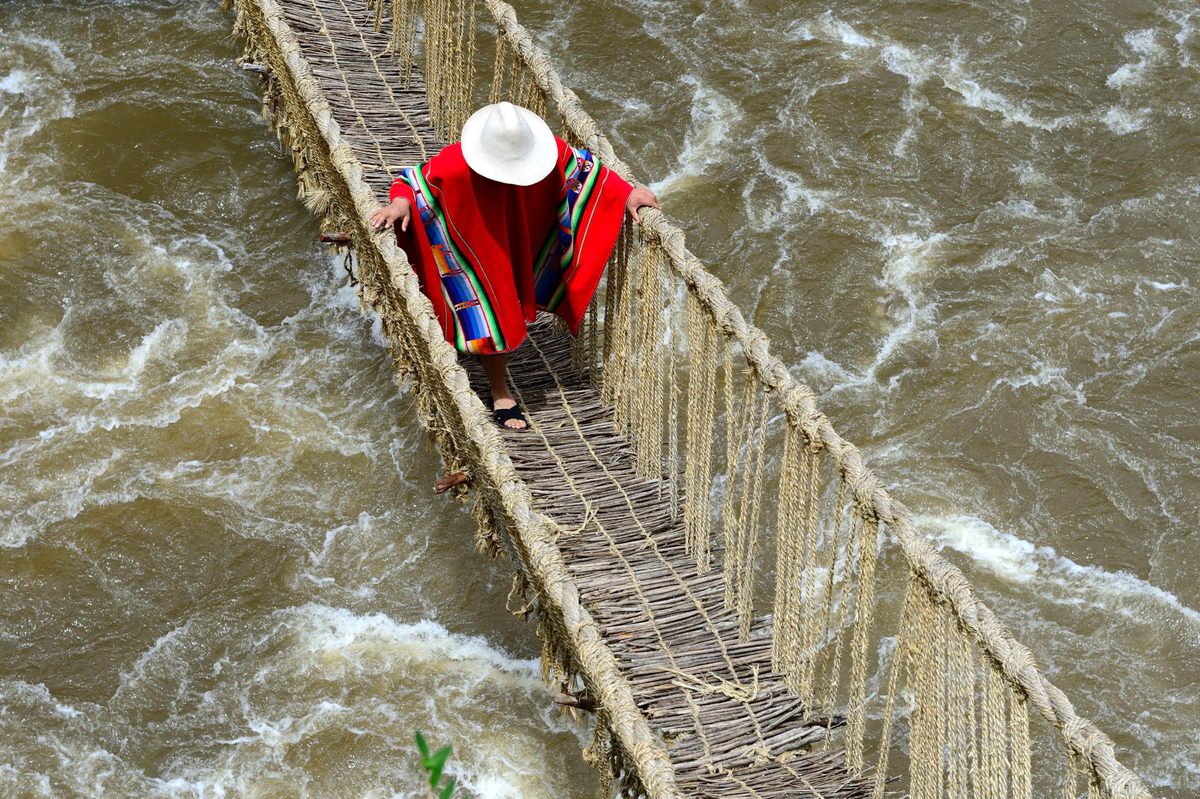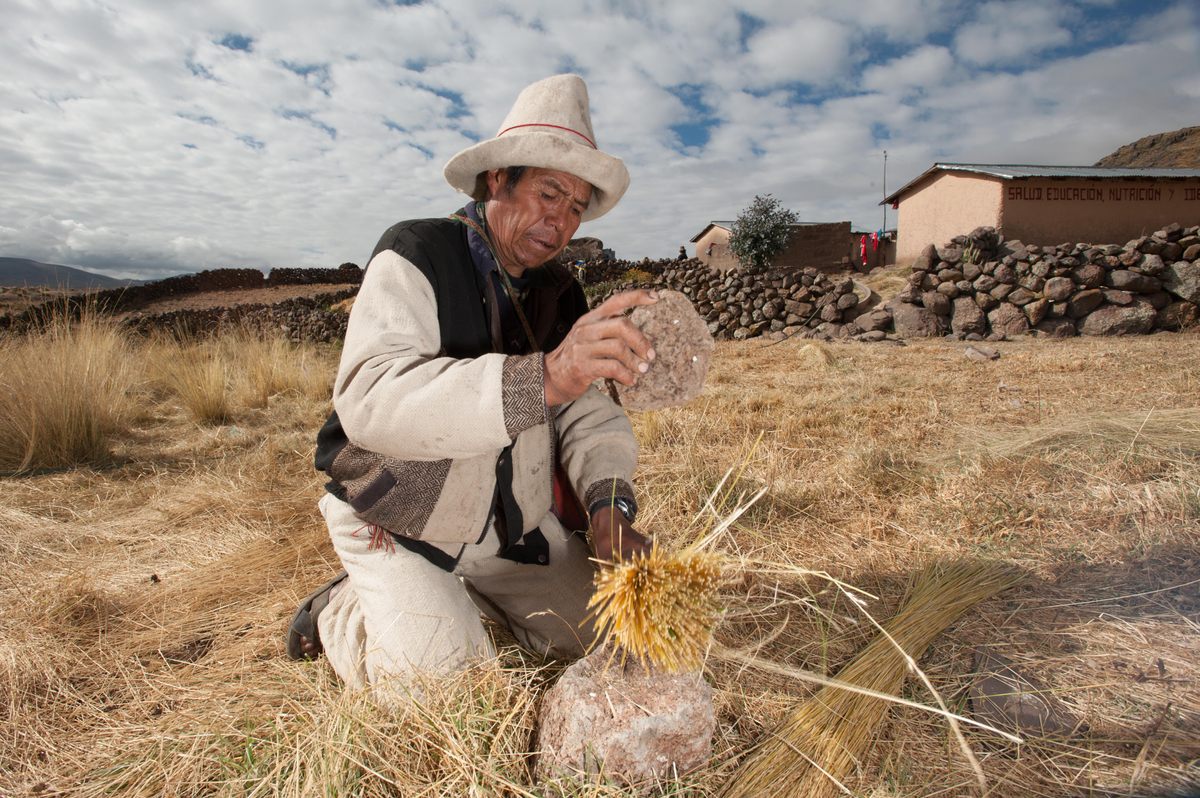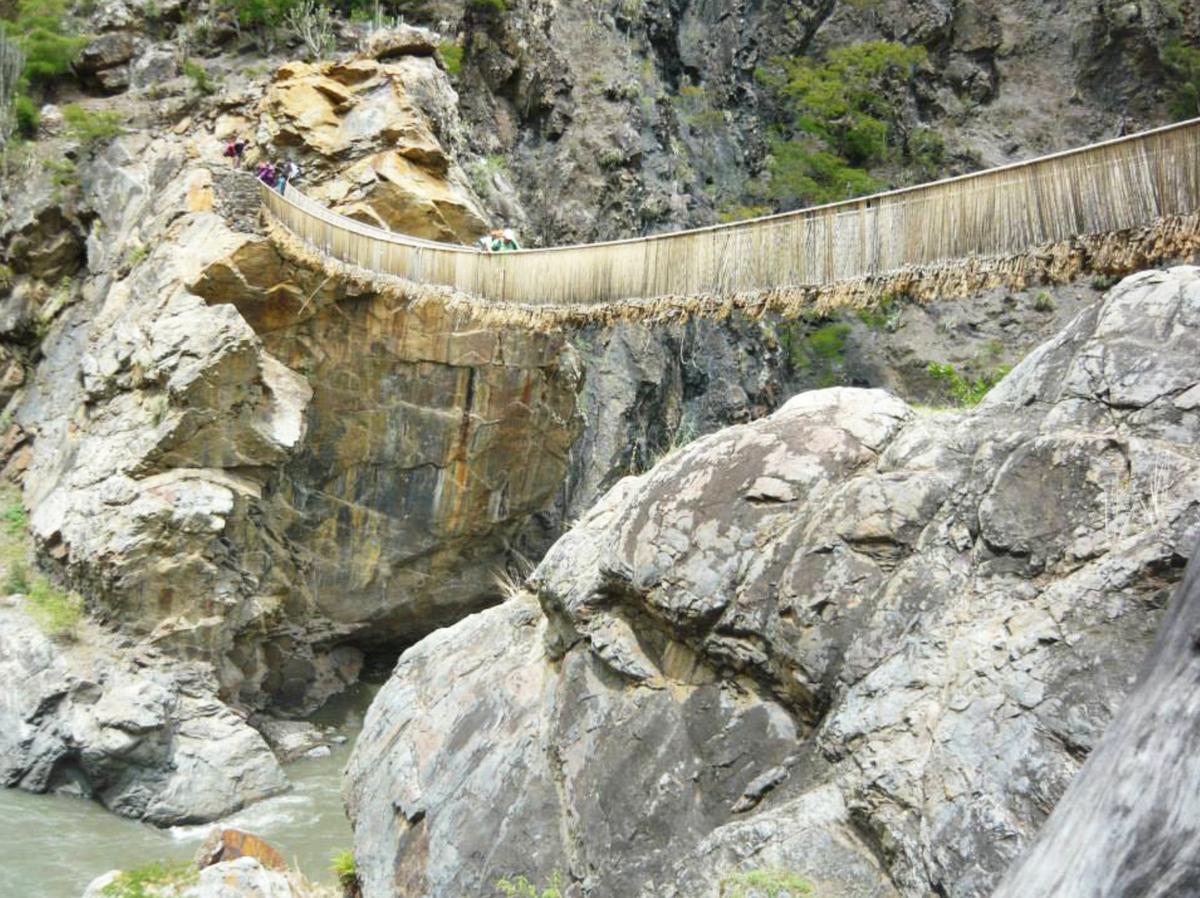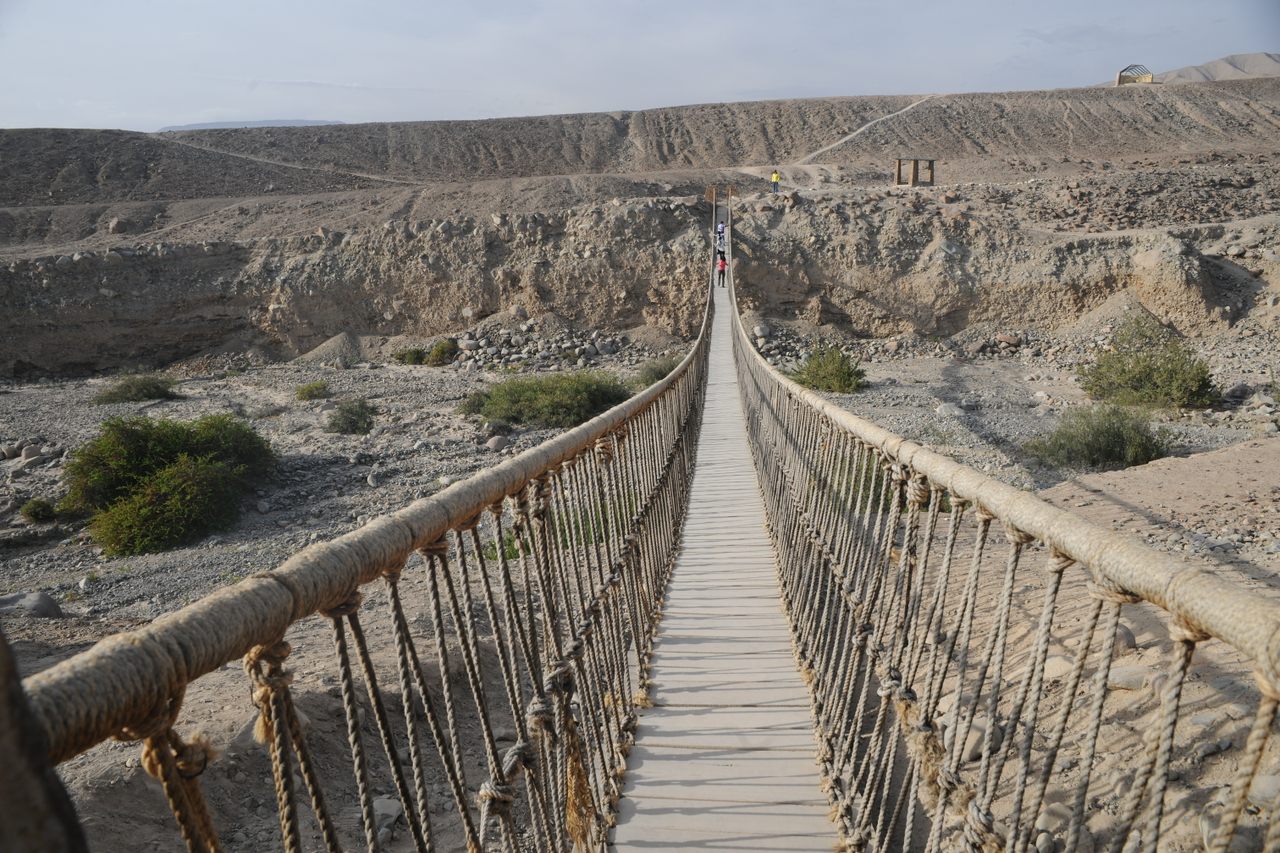Peru’s Incan Rope Bridges Are Hanging by a Thread
A remarkable ancient technology and tradition that united communities in the Andes is fading into history.
This story was originally published on SAPIENS and appears here under a CC BY-ND 4.0 license.
One early January morning in the mid-1980s after a daylong journey from Ayacucho (formerly “Guamanga”), I (Lidio) found myself being guided across a small rope bridge hanging across the Pampas River. This was my first experience on such a bridge, made with an astonishing ancient technology that uses twisted branches to form a crossing. Although it looked to be only about 20 meters long, the bridge, called Chuschichaka, was beautiful: a reminder of ancient times, when similar bridges existed along trails and roads that linked the Inca Empire.
From the town of Chuschi, where I started my journey that day, my destination of Sarhua seemed to be just nearby. But because of the rugged landscape, the trip was long and exhausting: It took hours to hike the distance, with the rope bridge in the middle. At last, our team arrived in Sarhua and was welcomed by the community with food, drinks, music, and dance. Their hospitality made our visit an incredible and unforgettable experience.
My mission at that time as an archaeologist was to investigate ancient agricultural terraces in the region. As I prepared for my work, I was told that there was an important activity taking place that day: the reconstruction of a larger bridge nearby called Tinkuqchaka.
Except for a few older and younger people who were staying in the town, most community members were already on their way to the site of Tinkuy (a name that means “a place to meet,” “a place to play,” or “a place to fight”) to take part in bridge reconstruction. Sadly, I could not spare the time to attend, though I would hear all about such work later from my friend and colleague—anthropologist Cirilo Vivanco (co-author), who is originally from Sarhua. When I left the community three days later in the early hours of the morning, Tinkuqchaka was not yet finished. We crossed the partially constructed bridge by flashlight, holding the handrails tightly.

The ancient practice of making hanging bridges has existed for a long time in Peru—perhaps going back as far as the Wari culture, which thrived from 600–1000. At one time, dozens of such bridges are thought to have connected communities across gorges and rivers. Today only a few remain, mainly for the sake of tourists, and even they are falling into disrepair. Just this April, the most famous of them—Queshuachaca, near the former Inca capital of Cuzco—collapsed from lack of maintenance.
The global appreciation of the hanging bridges of the Andes goes a long way back. In 1877, American archaeologist E. George Squier published Peru: Incidents of Travel and Exploration in the Land of the Incas, in which he devoted a few pages to the great hanging bridge over the Apurímac River on the main road to Cuzco. The bridge was built over a gigantic valley, enclosed by enormous and steep mountains. The structure, over 40 meters long and entirely made of plant materials, was hung from massive cliffs on both sides. To Squier, the bridge looked like a mere thread, a frail and swaying structure, yet frequently crossed by people and animals, the latter carrying loads on their backs. Travelers timed their day’s journey to reach the bridge in the early hours of the day before the strong winds came that made the bridge sway “like a gigantic hammock.”
Squier was very impressed, saying that his crossing was an experience he “shall never forget.” His description and accompanying image of the bridge no doubt captured the imagination of everyone who got hold of Peru: Incidents of Travel and Exploration in the Land of the Incas—including American explorer Hiram Bingham, famous for reporting the existence of the spectacular Inca city of Machu Picchu to a global audience in 1911. According to historians, one of the reasons Bingham decided to go to Peru in the first place was precisely the illustration of the Apurímac hanging bridge he saw in Squier’s book.

Long before Squier, Spaniards were impressed with the Inca hanging bridges, too. Early Spaniards, such as Pedro de Cieza de León, were fascinated. But the arrival of the Spaniards had devastating effects for local Indigenous peoples. Europeans brought diseases that decimated the Indigenous populations. Communities were reduced or totally deserted. Spaniards’ interest in precious minerals, such as gold and silver, also switched the efforts of Indigenous peoples to other activities, often leaving unattended other communal obligations, such as building the bridges.
Three years after my first trip to Sarhua, I was back again, this time on a mission to register the archaeological sites scattered around Sarhua along with Cirilo. On our way, we crossed Tinkuqchaka again and bathed in the Pampas River below the bridge.
As we watched the bridge swaying delicately over the river, Cirilo told me about how Tinkuqchaka, being built entirely of plant material, required annual maintenance and a total renewal every two years. He also told me how the community, including himself, came together to do this. From my conversations with Cirilo, the story of this touching activity became clear to me.
Following ancient Andean ideals, the community of Sarhua is divided into two groups or ayllus. One of the ayllus is regarded as local while the other is said to be made up of “outsiders,” perhaps the descendants of peoples who were relocated by the Inca from elsewhere within the Inca realm. Both ayllus coexist side by side, and it is believed that such a division is necessary to maintain a balance needed for the well-being of the community. Sarhua residents do not usually highlight their group membership, except during communal activities like the bridge rebuilding.

One person, named by the community, is responsible for looking after the bridge. As in Incan times, the title of this person is chakakamayuq. Bridge renewal begins with a notification by the chakakamayuq to the community, which begins collecting the necessary construction material—the branches of a bush named pichus. Then, on a specified day, community members descend from Sarhua, carrying on their shoulders pichus branches to Tinkuy.
Kumumpampa, an open space found near the bridge, is the gathering place. At this location, both ayllus take their respective positions, the local ayllu closer to Sarhua and the ayllu of outsiders closer to the Pampas River, symbolically distant from Sarhua. After necessary logistical discussions, the ayllus exchange jokes and challenge each other, thus making the whole activity an entertainment or spectacle. For the participants, it is a competition between the two ayllus but also a game, time to play and time to tease and mock the opposition.
The task ahead for both ayllus is, first, to produce 23 ropes 100 meters long, called aqaras, from the pichus branches. Bundles of nine pichus branches are tied together and braided. The ayllu that produces more ropes will be declared the winner. Defeat is shameful, and thus both ayllus strategize to ensure victory. This is largely a male activity, but women of both ayllus are engaged by preparing meals and cheering for their respective side, mocking the men of the opposite ayllu.
Producing the aqaras is only the first challenge. The second task is to produce five thicker cables from the aqaras. This is a more difficult job. Starting at a middle point, teams from the ayllus build half of the cable working outward, again in competition. Experienced members are in charge, while younger members observe, fully aware that in the future it will be their turn. At the end, one of the ayllus emerges the winner and is celebrated with loud shouts. Victory is sweet and joyful, while defeat is ugly, painful, and agonizing.
Upon completing the five cables, work shifts to the edge of the river, on either side of which stands a stone tower. Members of the outsider ayllu cross to the opposite side of the river using the old bridge for one last time; then the old bridge is cut at both ends and is carried downstream by the Pampas River, thus marking the end of a cycle and reinforcing, temporarily, the separation of the outsiders.
The renewal of Tinkuqchaka illustrates the complementary role of the ayllus and their necessary reunion for the vitality of the community. Local ayllu members throw ropes to the opposite bank of the river, retaining one end in their hands. Since bridge construction takes place during the rainy season, when the river carries lots of water, this is not an easy task. The local ayllu ties the rope to the first thick cable so it can be pulled across the river. The cables are as thick as a person’s body, made of wet branches and heavy. It takes hours to pull the five cables across the river and tie each securely behind the stone tower on the far side.
Three cables, pulled taut and horizontal, become the base of the bridge over which small sticks are laid transversely and fastened to the cables by cords. Two smaller cables become the handrails.
The whole task of completing the bridge takes about five days, during which time the entire community remains at Tinkuy. While the days are spent working, evenings are time to socialize, drink, sing, and dance, and thus renew the sense of community. The community, aware of the historical significance of the bridge, is also proud of being responsible for carrying forward this tradition.
The technology employed to build Tinkuqchaka appears to be ancient. The manner by which the bridge is built perhaps also resembles ancient customs. No one knows for sure. The fact that communities such as Sarhua are capable of undertaking such impressive construction and engineering feats shows the power of unified action.

There is the possibility that hanging bridges predate the Inca Empire. Large sections of the Inca royal highway already existed before the Incas, and along the same roads, there were several river crossings, thus suggesting that the bridge technology already existed. Demonstrating this possibility, of course, is not easy. There are no written records from this time, and the plant material of the bridges left no archaeological traces.
The hanging bridge constitutes an important symbol of the technology developed by the forebears of the Indigenous peoples of this region (including myself and Cirilo). In a perfect world, it would be rightfully considered a monument to the creativity and imagination of the Indigenous peoples of the Andes and maintained to showcase to the world this unique achievement of unknown origins. Of course, there is no such perfect world, and decision-makers have other priorities. As Andean philosophy teaches, everything has an end. The hanging bridges are not an exception.
For the residents of Sarhua, a cable bridge was built in 1992 that effectively ended the biennial construction of the rope bridges. In 2007, a larger bridge that could carry cars was built. Tinkuqchaka was made anew in 2010 and reconstructed for the last time in 2014 for the sake of tourism. The local youth seem uninterested in renewing the tradition.
It appears we have come to witness the end of something wonderful, unique, and to foreign eyes, spectacular. Something that was present almost everywhere in this region is fading away forever, and some of us who had the fortune to see and walk on these bridges sometimes took them for granted, without realizing that within our lifetime an important chapter of Andean history was coming to an end.









































Follow us on Twitter to get the latest on the world's hidden wonders.
Like us on Facebook to get the latest on the world's hidden wonders.
Follow us on Twitter Like us on Facebook